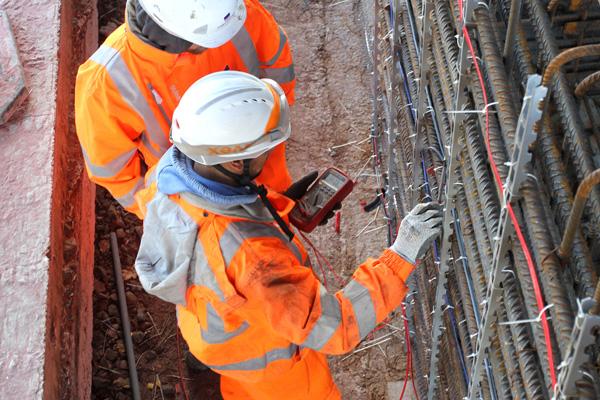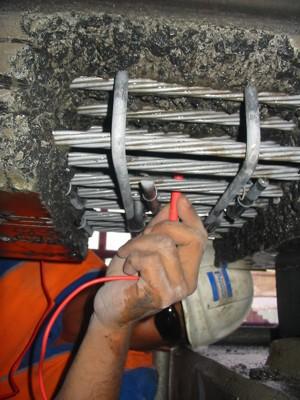Cathodic protection
Cathodic protection
Reinforcement corrosion is the major cause of deterioration of concrete structures. Good quality concrete provides a highly alkaline surrounding to steel reinforcement. If this alkalinity reduces, the reinforcement becomes susceptible to corrosion. The expansive forces caused by corrosion and rust formation are sufficient to cause concrete to crack and spall, leading to a need for concrete repair.
There are two main mechanisms that cause concrete deterioration: carbonation and chloride attack. Carbonation is caused by atmospheric carbon dioxide, which dissolves in water to form carbonic acid. This acid progressively penetrates and reacts with concrete, reducing the pH value from 13 to 9. At the reinforcement layer, the steel doesn’t passivate and begins to corrode. De-icing salts, seawater and marine aggregates are common sources of chlorides. Where chlorides can penetrate down to the reinforcement layer, they will aggressively attack the steel; therefore, starting the corrosion process. The rate of both carbonation and chloride attack depends on the concentration of carbon dioxide in the atmosphere, chlorides at the concrete surface, concrete permeability, density and concrete moisture content. Cracked or poor-quality concrete will deteriorate faster.
Conventional patch concrete repairs to damaged concrete are unlikely to be successful where carbonation has progressed behind the reinforcement layer, or where chlorides remain in sufficient concentration in adjacent untreated concrete. Cathodic protection, which works by passing a small electric current through the reinforcement layer, has several significant advantages over other available techniques: it is a continuous process that both stops existing corrosion and prevents future attacks; it is a permanent ongoing solution that does not require reapplication; it is suitable for severely damaged concrete; it is effective against both carbonation and chloride attack; its effectiveness can be controlled and monitored; it is cheaper than complete replacement; it is particularly suited to highway and marine structures where recontamination is likely.
Cathodic protection solutions can be used to control the progression of corrosion in reinforced concrete structures by:
- Preserving a protective environment around the reinforcement.
- Stopping the corrosion initiation process in the reinforcement.
- Preventing the progression of corrosion in the long term after repairing the structural damage it caused.
Cathodic protection solutions work on the area surrounding the steel, or on the reinforcements themselves by:
- Treating the facing to slow down or stop the penetration of pollutants before they reach the reinforcement.
- Depolluting the coating to restore the protective environment around the reinforcement.
- Protecting the reinforcement with an electrochemical process to stop the corrosion.
Freyssinet Australia, as a principal contractor, undertakes condition assessment, design, supply and installation of the cathodic protection system.
We can design, supply and install Impressed Current Cathodic Protection (ICCP), hybrid or galvanic systems.





